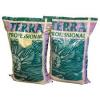Still looking through Files..this might explain what I mean about Ratios..Plus I think I've found an Old R.I.U. Thread?? anyway first up ~
This write up is from a "03" edition of HT Organically speaking
UNDERSTANDING NPK
Cookin' up chronic requires an understanding of N-P-K. This stands for nitrogen, phosphorus, and potassium
respectively. These are your primary nutrients. All plant-food labels include the percentage of these three
elements in numerical form. N-P-K levels must change to correspond with the different stages of your plant's
growth. There are secondary nutrients and micronutrients also, but these are needed in very small amounts, and
will be present in sufficient quantities as long as you use quality organic fertilizers. You will not need to
know specific amounts , nor will you need to manipulate them.
Within the vegetative cycle, there are separate of growth to recognize. Seedlings with one or two sets of leaves
requires very low primary nutrients to encourage growth. Plants with five-bladed leaves and rooted clones qualify
as early vegetative, and graduate to mild feeding. The next stage is mid-vegetative, and requires aggressive
feeding for robust growth. The week be for initiating flowering is called late vegetative, and is a good time to
throttle back nitrogen by 25% and prepare plants for flowering by feeding 50/'50 mix of bloom and grow
formulas[see below for details]. The flowering cycle also has early, middle and late stages
growth that call for diet adjustments.
Here's my recommendation for N-P-K ratios throughout your garden's life. The length of time between stages
is up to you. You might want to grow six foot trees or a table of one Sea of Greens.
VEGETATIVE:
Seedlings 2-1-2
Early Vegetative 4-2-3
Mid-Vegetative 10-5-7
FLOWERING:
Cycle Changeover 7-7-7
Early Flowering 5-10-7
Mid-Flowering 6-15-10
Late Flowering 4-10-7
Even more important than the actual numbers is the ratio of each of the primary nutrients to each other. The
reason why one farmer can grow using nutrients with a rating of 15-30-15 and another can get identical results
using 5-10-5 is because the proportion of each nutrient is the same. During the vegetative-growth stage,
phosphorus levels should be maintained at 1/2 that of nitrogen and potassium at 1/2-2/3 that of nitrogen. During
flowering, phosphorus takes the lead: Give nitrogen at 1/2 and potassium at 1/2-2/3 the strength of phosphorus.
Notice that potassium is consistently maintained throughout both stages at 1/2-2/3 the level of the main
nutrient. Staying close to this ratio will make sure you don't have a nutrient lock up, when unused nutrients
combine to form compounds that your plant can't use.
And R.I.U. Thread ~
https://www.rollitup.org/t/the-best-n-p-k.282713/


